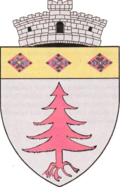Ocoliș (Alba)
|
Ocoliș Alsóaklos |
||||
|
||||
| Basic data | ||||
|---|---|---|---|---|
| State : |
|
|||
| Historical region : | Transylvania | |||
| Circle : | Alba | |||
| Coordinates : | 46 ° 29 ' N , 23 ° 28' E | |||
| Time zone : | EET ( UTC +2) | |||
| Height : | 450 m | |||
| Area : | 85.79 km² | |||
| Residents : | 616 (October 20, 2011) | |||
| Population density : | 7 inhabitants per km² | |||
| Postal code : | 517525 | |||
| Telephone code : | (+40) 02 58 | |||
| License plate : | FROM | |||
| Structure and administration (as of 2016) | ||||
| Community type : | local community | |||
| Structure : | Ocoliș, Lunca Largă , Runc , Vidolm | |||
| Mayor : | Alin-Alexandru Jucan ( PNL ) | |||
| Postal address : | Str. Principală, no. 152 loc. Ocoliș, jud. Alba, RO-517525 |
|||
| Website : | ||||
Ocoliș (outdated Ocolișul Mare ; Hungarian Alsóaklos or Nagyaklos ) is a Romanian municipality in the Alba district in Transylvania .
Geographical location
The municipality of Ocoliș is located in the north of the Alba district on the left of the Arieș - a right tributary of the Mureș (Mieresch) - in the Apuseni Mountains , between the Trascău and Muntele Mare mountain ranges . One kilometer from Drum național 75 , the place Ocoliş is about 30 kilometers southwest of the city of Turda ( Cluj County ); the district capital Alba Iulia (Karlsburg) is 45 kilometers (as the crow flies) south of Ocoliș. Ocoliș is part of the historical Motzenland .
history
According to reports by R. Münsterberg and J. Öhler from 1902 and G. Téglás , archaeological finds in the area of the municipality (in the incorporated village of Vidolm ) were linked to the Roman era .
The place Ocoliș, a former Romanian serf village that belonged to the municipality of Rimetea ( Eisenburg ) - was first mentioned in 1408 under the Hungarian name Aklos .
Today the residents live mainly from cattle breeding, forestry and the mining of Dazite .
The narrow-gauge railway Turda-Abrud (93 kilometers), which runs through the town , was put into operation in 1912 and closed in 1998. The station and a bridge of the railway on the area of the community have been listed since 2006.
population
In 1850 there were 1770 inhabitants in the area of today's municipality; 1764 of them were Romanians and six were Roma . In 1941 the largest population was registered with 1883, also that of the Romanians (1870). The highest number of Hungarians (22) was recorded in 1920 and Roma in 1850. In the 1890 census, a German was registered in the incorporated village of Vidolm (ung. Vidaly ). The population (1412 in 1977) has decreased significantly in the last few decades; In 2002, 846 people lived in the community.
Attractions
- Old farms with thatched or clapboard wooden houses.
- The wooden church Botezul Domnului in the incorporated village of Lunca Largă (ung. Lunkalárga ), built in the 18th century, is a listed building.
- The wooden church Sf. Arhangheli in the incorporated village of Runc (Hungarian Aranyosronk ), built in 1733 and renovated in 1852, is also a listed building.
- The Cheile Runcului and Cheile Pociovaliștei natural reserves , in the northwest of the municipality.
Web links
Individual evidence
- ↑ 2011 census in Romania ( MS Excel ; 1.3 MB)
- ↑ Mayoral elections 2016 in Romania ( MS Excel ; 256 kB)
- ^ Dictionary of the localities in Transylvania
- ^ Institute Of Archeology - Ocoliş, accessed March 26, 2010 (Romanian)
- ↑ a b Heinz Heltmann, Gustav Servatius (Ed.): Travel Guide Siebenbürgen. Kraft-Verlag, Würzburg 1993, ISBN 3-8083-2019-2 , p. 138.
- ↑ a b Ocoliș ( Memento of April 13, 2010 in the Internet Archive )
- ↑ Pictures of the narrow-gauge railway between Turda and Abrud , on YouTube
- ^ Official Journal of Romania of May 18, 2006
- ↑ Census, last updated October 30, 2008, p. 129 (Hungarian; PDF; 1.2 MB)
- ↑ a b List of historical monuments of the Romanian Ministry of Culture, updated 2010 (PDF; 7.10 MB)
- ↑ The natural reserves Cheile Runcului and Cheile Pociovaliștei , at www.karpatenwilli.com





